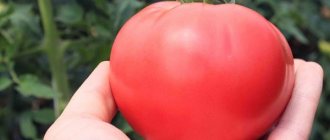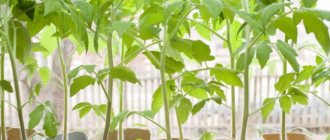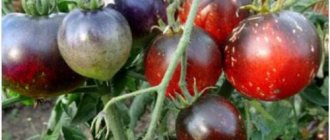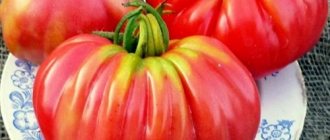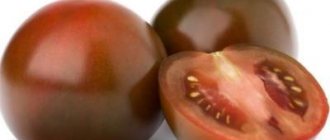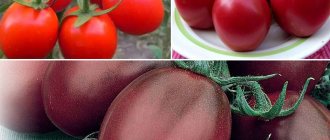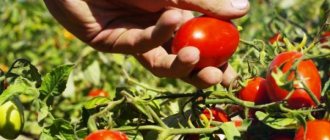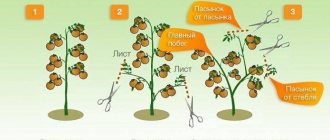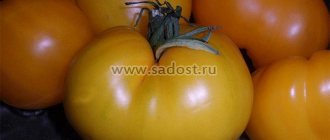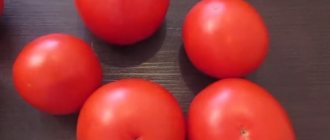The red giant is a classic representative of large-fruited and red tomatoes - indeterminates. It is valued for its productivity, adaptability, and excellent taste.
| Height | Landing location | Ripening time | Fruit color | Fruit size | Origin | Fruit shape |
| Tall | Greenhouse, Open ground | Mid-season | Reds | Large | Variety | Flat-round |
Characteristics, description of the variety
The red giant stands out among other tomato varieties due to its size. You can recognize it not only by its size, but also by the bright red color of the fruit, round, slightly flattened shape, and unpronounced ribbing. The plant reaches a height of 140-180 cm, has long drooping leaves. One bush can contain up to 6 fruits.
Advantages and disadvantages
The Red Giant tomato was developed in the USSR and quickly earned people's love due to its excellent characteristics.
Namely:
- High taste qualities. Due to their high sugar content, these tomatoes are tasty both fresh and after processing. “Red Giant” is a juicy variety: its moisture content is about 95%.
- Large fruit size. One tomato weighs 450-650 g, and at the first harvest it can reach 850 g.
- High resistance to diseases.
- Possibility of growing both in greenhouses and in open ground. It grows not only in warm regions, but also in the north (but only in heated greenhouses).
However, the variety also has some disadvantages:
- Low yield compared to other tomato varieties.
- Picky about soil.
- Short shelf life of ripe vegetables.
general information
The name of the variety already explains a lot - the tomato is large and red in color. It was developed by agronomists, which has been on the market for a long time and has proven itself to domestic and not only gardeners. The tomato is intended for growing outdoors, but in warmer regions, in temperate climates - in film greenhouses, in the north - in warm greenhouses. This is a productive and very productive variety, with very tasty and juicy fruits. Growing has its own subtleties.
- Indeterminate type, the bushes are quite powerful and tall - up to 1.6-1.8 meters.
- Shaping and tying required.
- Produces consistently large fruits – weighing 500 grams or more.
- The pulp is fleshy, sweet, many call it watermelon.
- Prefers greenhouse cultivation.
- The root system is powerful; no more than 2-3 plants are planted per square meter.
- The fruits are round and slightly flattened.
- Ideal for preparing summer salads, juice, pasta, ketchup. Because of their size, you can’t cover whole fruits.
- The skin is red, the pulp contains an average amount of seeds.
- The leaves have a rich green tint, the fruits ripen in clusters.
- It has an average ripening period of 110-120 days.
- It is resistant to a number of diseases, but manufacturers do not talk about absolute immunity.
- Productivity – 7-8 kg. Fruiting is long lasting.
Resistance to diseases and pests
The variety itself is highly resistant to diseases and pests. But if not properly cared for, it is susceptible to diseases.
Important. You should choose the right soil for planting (neutral is perfect), carefully monitor the watering and lighting of the plants, and do not forget to regularly ventilate the greenhouse.
Thrips, aphids, spider mites, greenhouse whiteflies and Colorado potato beetles are the most dangerous for this variety. These are common pests that most modern drugs successfully combat.
Keep in mind that almost all insects lay larvae in the soil in the fall, so after harvesting, dig up the soil to avoid pest problems in the spring.
Advantages and disadvantages
Pros:
- immunity to common tomato pathogens;
- resistance to weather stress factors;
- stable, uniform productivity;
- ripening from July to autumn;
- excellent product and taste indicators;
- good germination;
- heat resistance;
- various methods of consumption and preparation.
Minuses:
- the importance of maintaining distances when planting (indeterminate variety);
- the need for formation and stepsoning;
- impossibility of whole-fruit canning.
Rules for planting and subsequent care
Proper planting and proper care ensure a good harvest of the “Red Giant”.
Reference. Experts recommend not buying seedlings, but growing them yourself to avoid the risk of getting diseased plants. Start planting in February-mid-March.
When preparing the soil for seedlings, pay special attention to disinfection: soak the seeds in a solution of potassium permanganate, and then rinse in running water. For the same purposes, it is recommended to scald the soil with boiling water.
Before sowing, it needs to be moistened. Then depressions up to 2 cm are made, seeds are planted in them and sprinkled with earth. Watering is done once every 3 days. Seedlings should be kept in a room with a temperature of 23-25 degrees. After the sprouts appear, the seedlings are transferred to the ground.
Remember that neutral soil is suitable, in the range of 6-6.5 pH. It must be carefully prepared for replanting: remove all weeds and grass, add humus, compost and sand in equal parts. If tomatoes are planted in a greenhouse, treat it for pests.
2-3 plant bushes are planted per 1 square meter of soil. The soil can be covered with mulch (chopped grass and plants). Water the tomatoes with settled water. The greenhouse must be systematically ventilated to prevent fungal diseases.
At the growth stage, complex feeding is needed: every 10 days it is recommended to alternate organic and mineral fertilizers (with phosphorus and potassium).
Important. Don't water tomatoes too often. To assess soil moisture, roll it into a ball. If it quickly rolls up and collapses when pressed, then the humidity is normal and watering is not required.
During the period of active growth, “Red Giant” is watered once a week, spending 20-30 liters of water per square meter. During the flowering period, water twice a week, one and a half to two liters per meter. The appearance of ovaries is accompanied by watering twice a week, 3-5 liters (if it is very hot, the volume is increased to 10 liters).
When the first fruits appear, it is worth watering only if the soil is very dry. The optimal time of day for watering is morning, since at this time of day the sun is not too aggressive and the soil has time to absorb all the moisture.
An important part of care is planting. This is the name for removing shoots to prevent the appearance of excessive fruit. This is especially important for the “Red Giant” variety, since too much fruit provokes a decrease in size.
The large weight of this variety of tomatoes weighs down the stems, and if there are a lot of fruits, it may break.
The bushes are pruned once a week, leaving the shoot to form a stem. It is better to do this in the evening (when it is not hot).
Important. Due to the large weight of the fruit, it is important to place supports under the branches of the plant.
Landing
Tomato seedlings are planted at the end of March or 55-60 days before transplanting to the garden bed. To obtain healthy seedlings, prepare nutritious soil from soil from the garden with the addition of humus, peat and sand, as well as a slightly smaller amount of wood ash. You can add a little superphosphate so as not to feed the seedlings in the future. The resulting soil must be calcined in the oven or disinfected with potassium permanganate.
Rules for growing seedlings:
- Disinfection of seeds (they are placed for an hour in a one percent solution of potassium permanganate, then washed).
- Sunny location.
- Before germination of plantings, it is warm (+25 or more), after germination, the temperature is no higher than +22 degrees, and in the first days of the bushes’ life it can be lower.
When 2 leaves appear, the bushes dive into the peat pots. 2-3 plants are placed in the garden bed.
Reviews
Enas, Ukraine: “Growing large tomatoes will not be difficult for me now, because I bought Red Giant tomato seeds.”
The tomatoes from them will turn out to be bright red in color and each of them weighs up to 500 grams. It’s a very interesting variety, I’ve never grown such a big one, but they suggested that the tomato variety is of high quality and resistant to various diseases.” Ekaterina, 30 years old: “I tried to grow the Red Giant tomato.” I'm happy with the result. Very tasty when processed, especially in ketchups!”
Alexander: “I consider the Red Giant tomato to be the best variety.” The most wonderful and sweet. I don’t grow green or yellow tomatoes; I think that the best ones are red ones, because they don’t get any sweeter.”
Growing and care
Water tomatoes only with warm water, being careful not to wet the stem and leaves, during periods when the bushes are not exposed to direct sunlight. Moisturize as needed, but regularly.
Irregular watering leads to cracking of fruits, especially in large-fruited varieties.
Feed 3-5 times. There are three basic feedings:
- on the tenth day after rooting of seedlings;
- at the beginning of budding and flowering;
- at the beginning of fruiting.
Young bushes need nitrogen more than other elements, while older bushes need potassium and phosphorus more.
Plants are tied to supports and formed into 1-3 stems. Excess ovaries are removed to obtain large tomatoes.
Features of growing the variety
Pre-sowing treatment for tomatoes is very important. Seeds need to be tested for germination in salt water, and any that float should be removed. Before planting, 3-4 days before planting, the seed can be soaked in a manganese solution for an hour, then rinsed and dried. And a day before sowing, soak the seeds in aloe juice for 2-3 hours - this will stimulate the immune system and speed up germination. Sowing begins in late February and early March according to the lunar calendar.
It is best to mix soil purchased and from the garden, since the variety is demanding in terms of composition. Proportions of 1/1 are suitable, but you definitely need to etch the soil with boiling water and manganese and then dry it. Plant seeds in a common tray or individual cups, which is more convenient under film. During germination, the temperature is needed at 26-28 degrees, after 23-25 degrees. In the phase of 3-4 leaves, seedlings are fed with urea.
Read also: Yaiguren pear variety description photo reviews
Transfer to the greenhouse and greenhouse is carried out from mid-May, when it became warm even at night - from +15 degrees. The soil is prepared and the entire greenhouse is treated with antiseptics. We have already talked about crop rotation. Humus and ash are added to the soil, dug up, and then a complex preparation is added to each hole. Be sure to pour boiling water on it. 2-3 holes are dug per meter. Since the variety is demanding on moisture, it is better to mulch the beds.
To get the maximum yield, all the shoots are planted, but one is left in the upper fork - this is the second stem. Every 10-14 days, additional feeding is carried out - the manure is diluted 1/10, the next time they are fed with complexes - “Superphosphate”, “Universal”. This is how they alternate throughout the growing season. To prevent diseases, they are sprayed once a week with a weak solution of manganese; to stimulate flowering, “Ovary”; insects are driven with infusions of spices.
If you follow these recommendations, you will not have any problems. Getting a good harvest is a reality, not a myth.
Video: Caring for tomatoes. First important steps
Adding an article to a new collection
Once upon a time, tomatoes whose fruits reached 200-250 g were considered large. Today there are already varieties of giant tomatoes with fruits growing up to 1-2 kg! And these are not just a huge, but low-value curiosity, but real bright, aromatic and tasty tomatoes.
There are a lot of varieties and varieties of large-fruited tomatoes - early and late ripening, for greenhouses and open ground, tall and short, requiring and not requiring pinching, for fresh consumption or for harvesting... Moreover, not all gardeners are chasing gigantism, many prefer large-fruited tomatoes measuring 400-600 g.
In this material, we tried to collect descriptions and characteristics of the largest varieties of tomatoes, which have proven themselves recently and are loved for their remarkable yield, resistance to diseases and not the most complex agricultural technology.
General information
Pink Giant tomatoes were bred by our breeders, and amateurs at that. Scientists have nothing to do with the appearance of this variety. At the same time, they claim that the Pink Giant tomato contains a third more nutrients than other varieties.
The peculiarity is that due to the presence in the pulp of a large amount of carotene, fiber, selenium, vitamin C and a number of antioxidants, these tomatoes have a noticeable sweetish taste.
Thus, the Novikov giant tomato appeared back in the days of the Soviet Union; seeds today are produced by many specialized companies - the Novikov giant tomato variety is in demand by generations of amateur vegetable growers.
The popular tomato Gigantella does not require care; even a novice gardener can grow it. In addition to Pink, there are other varieties of tomatoes:
- This is the Siberian Giant, which grows in changing summer conditions.
- Leningrad giant tomato.
- Red giant, bred by agronomists. The name fully characterizes the description of the tomato.
- Slivka Red is a giant tomato of corresponding shape and color. There is also yellow cream. Although what a cream this is - big plums!
- A very beautiful tomato - Giant Rose.
Crimson, with yellow veins. - No less interesting is the color of the tomato Azure giant f1.
The fruits are not just purple, they are also chocolate color. According to reviews from those who grew this tomato, its excellent table taste is unforgettable! - Another result of Russian selection is the Sugar Giant. Summer residents have known these sweet tomatoes for about 20 years. Judging by the reviews, the Sugar Giant tomato is not only tasty, but also undemanding in care.
- Honey giant tomatoes have a pleasant warm yellow color.
The advantage of this variety is that, like all yellow varieties, it does not cause allergies. The taste of tomato is sweet. - Gardeners also love the giant Lemon tomato.
This variety is demanding on soil fertility. Careful care will generously pay off with bright, large yellow fruits. Judging by the description and reviews, this tomato is amazing. Reviews of the Lemon Giant tomato are mostly enthusiastic. - American breeder Claude Brown worked for several decades to create his variety of yellow giant tomato. The result was excellent.
- Tomatoes Early giant f1 will ripen within 80 or, as reviews show, 85 days after sowing.
In agricultural technology, all giant tomatoes are similar to the Pink Giant tomato variety. Tomatoes should be grown in areas where carrots, cucumbers, salad greens or zucchini previously grew.
Advantages of the variety:
- large tasty fruits;
- high content of nutrients;
- low maintenance;
- resilience;
- fruits are good fresh and processed;
- the ability to store fresh fruits for a long time without losing their properties;
- tolerates long-distance transportation well;
- resistant to a number of diseases.
Disadvantages of the variety:
- the inability to pickle tomatoes in jars due to their large size;
- branches require strong support and garters;
- the variety is susceptible to damage by harmful insects;
- The pink giant needs systematic pruning and pinching.
Description of the tomato Giant Red
Currently, a large number of different hybrids of nightshade crops have been created. Each variety has its own advantages and disadvantages; sometimes it can be very difficult to make a choice in favor of one hybrid or another. In order not to make a mistake, before purchasing planting material or seedlings, you need to study the description of the variety.
Red Giant tomatoes were created in the 80s in the USSR through the process of amateur selection. In 1989, the tomato was included in the State Register as a variety suitable for cultivation in closed and open ground.
A plant with early fruit ripening. The first red tomatoes appear 100–105 days after sowing the planting material. After about 130 days, the fruits begin to ripen en masse.
The Red Giant tomato is an indeterminate tomato, characterized by unlimited growth of the main stem. It can reach a height of up to 5 m when grown in open ground. The average height of the plant is 1.8 - 2.5 m. The bushes themselves are very branched, the brushes can be either simple or complex. The plant is not standard.
It is advisable to grow the variety in garden beds in the southern and central regions. In northern latitudes, it is preferable to plant tomato bushes in greenhouses or greenhouses. The plant gives a good harvest regardless of the planting location.
They are distinguished by good resistance to most diseases of nightshade crops.
